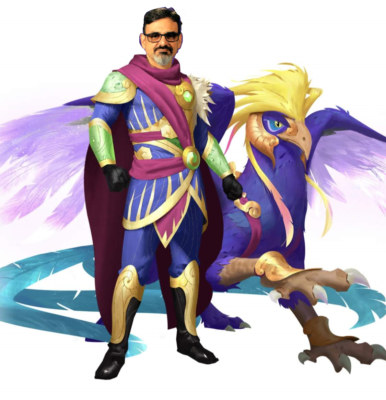To make learning in school more playful and game-like, I’ve been working with Gamification for years. By gamifying my courses I continue to teach what I have always taught but more like a game than a school course. Running my class like a game makes it more exciting than just learning Science (or learning how to pass tests). When I went from teaching all subjects to teaching just Science I thought I had it made. Science is so exciting! We can do projects and labs, I mean, who wouldn’t like that? Well, there were kids who didn’t enjoy projects or labs and still didn’t engage. And then when I incorporated robotics with engineering, designing, and programming, I was sure that would do the trick. What students wouldn’t like that? To my utter dismay, I’ve learned over the years that no matter the project, the lab, the robot design challenge, there will be students that are just not interested and will not engage. I just couldn’t believe that not all kids are intrinsically motivated to learn and do Science or STEM or STEAM. After all, engaging students with whatever we are teaching is the key. If they engage with it they have a better chance to learn it.
When kids play games, whether it be foursquare in the playground during recess or Fortnite with friends on their Xbox, they are thoroughly engaged and so motivated. I wanted that in my classroom. Did gamifying my courses do it? Were more students engaged? Spoiler: yes and no. Some aspects of the gamification techniques I incorporated appealed to some and some aspects appealed to others but as with anything, there was no silver bullet. Following are gamification elements that I tried and how they worked at motivating and engaging my students:
- Experience Points or XP – this makes sense to a lot of students, especially those who play video games or games on their phones. Here are my thoughts on using XP for grading.
- Leveling Up – this also makes sense to a lot of students. In video games, leveling up makes the character stronger or gives powers or abilities.
- Questing – just calling an assignment a quest, or just calling a test a Boss Battle doesn’t do much. The power of questing is in giving kids choices. We are all motivated by having choice. Giving kids choices in what they learn, or in what order to do assignments, or how to show what they learned, this is motivating. Quest-Based Learning (QBL) is more motivating and engaging for students and can look like one assignment branching off into multiple choices for what kids do next. Here are my thoughts on QBL.
- Badges – some kids are motivated by collecting evidence of their accomplishments. Badges used as evidence of accomplished work well. For example, as part of a science unit on energy, kids who successfully complete all the assignments, labs, quizzes, and the final test would earn the Energy Badge. That badge has meaning, it’s like receiving an A for that unit. A collection of badges in that Science class can demonstrate all that the student has mastered, and for those who haven’t earned a certain badge, they will know which assignments they have to make up or if they have to study to re-take the final assessment.
- Guilds – Teaming and how you setup your class teams. Can be fun for kids, especially if teams get to complete against each other sometimes and work together as a whole class sometimes.
- Leaderboards – Can work to motivate but only for those kids at the top. Horrible for the kids at the bottom so I stay away from this one.
- A Story Element – this makes your class an adventure. What story can students be a part of when they enter your classroom? Here’s what I chose for my class story.
The story element was the one that came last from the above list for me. I tried using badges, quests, and giving students XP instead of grades and points. It was hard to keep track of all that. Gradebooks were made for grades. Then I found a great Learning Management System (LMS) that was entirely gamified, Rezzly, giving students XP for assignments, keeping track of levels and the perks that come with leveling up, and assigning badges for completion of units of study. It was great for me to keep track of who was doing what and to give kids individual feedback on work they needed help completing. For the students, it was great for some, lukewarm for some, and others didn’t really care for it.
Rezzly gave way to Classcraft. Classcraft was similar to Rezzly in that I could have all my assignments in the system but it gave kids more of a game-like feel with avatars, gold, pets, and real-life powers when they leveled up! Here’s a post I wrote explaining why I went to Classcraft over Rezzly. Classcraft is the tool that engages all my students, every single day of the year. Because we use it everyday either to start class or for working on assignments, labs, or projects, I can truly say that. So gamification with Classcraft will engage all my students. Every student I’ve worked with in the past three years have enjoyed checking their Classcraft account every day. I don’t have any hard evidence but it feels like kids are doing more work because of the fact that they get to access Classcraft and gain XP by doing classwork and turning it in via Classcraft! They also get XP for positive classroom behavior so that has improved, too! Is it perfect? Have I found my Shangri-La? No, I still have students who misbehave and I still have students who don’t do their work, and I still have students who do not pass their tests. But I have seen an improvement and there is more enjoyment in class. So I’m sticking with it!
So there it is. That’s what I’ve learned so far about gamification in education. Classcraft has worked the best for my students and allows me to include my Star Trek story theme, and allows me to treat my class like a game with XP and leveling up and powers.
Next, I’ll share how I’m doing with game-based learning (GBL). If anyone reading this post is gamifying their courses or thinking about it, what have you tried or what would you like to try? Share in the comments below.









































































